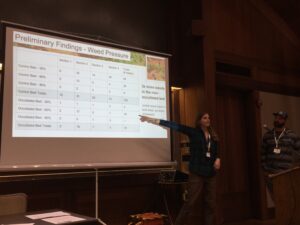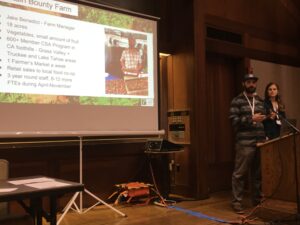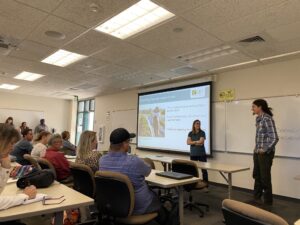Final report for OW19-345
Project Information
Effects of Occultation on Weed Pressure, Labor Costs, Product Quality, and Yield in Sustainable Vegetable Production in Northern California
Organic row crop vegetable growers are overly reliant on tillage to manage weed pressure due to their inability to spray herbicides. These farms are limited in methods they can employ to control weeds. For small-scale farms that are attempting to reduce/eliminate tillage, the main method used for cultivation is hand labor which is increasingly expensive and hard to find. Recently, growers across the United States have started experimenting with a process called occultation. Occultation involves irrigating a growing area and then putting a black, 5 millimeter tarp over the top of a growing bed and leaving it there for 2-6+ weeks. Weeds in the bed germinate in warm, moist conditions, and die due to lack of light. Once the tarp is removed, the clean seed bed is planted/seeded and minimal soil disruption occurs.
Our research question simply is, “What positive effects does occultation have on produce production?” More specifically we will measure the effect of occultation on labor hours, product quality and yield, and weed pressure in the growing area. After the results are gathered, we will co-present the research findings at two conferences (CA Small Farm Conference, Ecofarm) to at least 50 people total and create two podcasts with two of the farmers we partnered with, which will be downloaded at least 200 times total. We will write a short report on the experiment which will be published for free electronically. We will print 200 copies of the report and distribute them at conference presentations. This practice is potentially significant because with minimal up-front investment, small-scale organic farms could significantly reduce costs, improve product quality, have higher profit, implement an environmentally friendly practice, and cause less wear and tear on their bodies.
- Help five produce farmers in Northern California implement occultation for a four week time frame in the test and treatment plots of the research trial at their farm. (May-July 2019)
- Oversee the planting, irrigation, and cultivation of the occultation treatment and control plot of five farms in northern California. (May-Sept. 2019)
- Manage data collection from five farms in northern California on how long they left the tarp on the occultation zone, how many labor hours went into both the control and treatment zones, and the amount of time that went into applying and removing the tarp. (May-July 2019)
- Measure the weed pressure and types in the occultation zone vs. the control zone at three points after tarp removal: 30%, 60% and 90% of crop maturity. (June-December 2019)
- Measure the produce quality of the crop in the occultation zone vs. the control zone at harvest. (September 2019 - January 2020)
- Measure the yields in each of the five plots (treatment and control) at harvest. (September 2019 - January 2020)
We have added all major project activities (related to the objectives) and all outreach activities to a GANTT chart that is attached. Please see that chart for more detailed information on who is responsible for what project activities during particular time frames.
| Timeline | ||||||||||||||
|
Tasks
|
People Involved, first name leads | April 2019 | May 2019 | June 2019 | July 2019 | August 2019 | September 2019 | October 2019 | November 2019 | December 2019 | January 2020 | February 2020 | March 2020 | April 2020 |
| Project Coordinator, farmers | Kick Off Call w/Farmers | |||||||||||||
| Farmers, Project Coordinator | mid-May to mid-July occultation @ farms | |||||||||||||
| Farmers, Project Coordinator | July-mid-Oct. production of crops in occultated area & data gathering | |||||||||||||
| Project Coordinator, Podcast Producer Contractor, Farmers | Oct-Feb. record, edit, and publish two podcasts | |||||||||||||
| Project Coordinator, 1-2 farmers | Present at Ecofarm | |||||||||||||
| Project Coordinator, 1-2 farmers | Present at CA Small Farm Conference | |||||||||||||
| Project Coordinator, Project Director, Farmers | Sept-Nov. Write, edit, publish, and print case study of research. | |||||||||||||
| Project Coordinator | Promote case study electronically, presentations at conferences, podcasts, and field days to other farmers and agricultural professionals. | |||||||||||||
| Project Coordinator, Project Director | Write up final report. | |||||||||||||
| Project Coordinator | Survey farmers that attended presentations & gave their contact info to see if they adopted occultation on their farm | |||||||||||||
Cooperators
- - Producer
- - Producer
- - Technical Advisor
- - Producer
- - Producer
- - Producer
Research
This project will include on-farm research at five organic, commercial vegetable farms in northern California. Some data will be collected by the farmers (in templates provided by CAFF), while other data will be collected by the CAFF Project Coordinator when she is at the farms. A more detailed breakdown of methods by objective is provided below.
Objective 1: The experimental design will be a complete randomized block design with four blocks at each of the five farms. Farms may trial either carrots or beets, but they will maintain the same crop in both the treatment and control sub-blocks, herein referred to as “plots”. Each plot within the experimental blocks will be 25-50 feet long and between 40-60 inches wide. All five farmers will occultate their treatment zones for four weeks prior to planting/transplanting into it. The Project Coordinator will lead this process and work one-on-one with each farm to make sure they execute all the steps correctly.
Objective 2: The experimental design will be the same as mentioned in objective one. Farmers will use the same production methods in both the control and treatment plot, except that the treatment plot will be occultated prior to planting/seeding. The control plot will be managed using typical ground management practices for that crop (e.g. tilled right before planting/seeding). Once the control and treatment plots are planted/seeded with the crop, they will both be irrigated & cultivated exactly the same (drip, overhead, weeded by hand, hula hoes, cultivating tractor, etc). The Project Coordinator will work one-on-one with each farmer to make sure this process is followed. There will be minimal work by the farmer except with placing the tarp and removing it.
Objective 3: Data will be collected on the amount of labor hours required to move the tarp on and off, to complete any minor maintenance during its use, and any time spent on cultivation. This will help determine a cost-benefit analysis of the tarping vs. non-tarping practice. This objective will require a fair amount of collaboration by each of the partner farms as they will be collecting these data and reporting to the Project Coordinator.
Objective 4: Measuring the weed pressure in the control vs. treatment zones at each of the farms will occur by gridding off two pre-selected, random 0.25 m² squares within the treatment and control plots and counting the number of individual weeds. Additionally the name of the weed varieties down to the genus will be recorded. Each partner farm will be expected to communicate the date of transplant/germination to the Project Coordinator and then the Project Coordinator will go to each of the farms at two and five weeks after that date to record weed pressure data. Weed pressure data will also be collected by the Project Coordinator on the date of first harvest of the crop.
Objective 5 & 6: Measuring the produce quality and yield in the control vs. treatment plots at each of the farms will occur by taking a composite sample of 10 units (carrots/beets) from each plot. The treatment and control plots will be gridded off into ten uniform sub-plots and one unit will be gathered from each block. Then all ten units will be photographed and notes taken on product quality (uniformity, surface defects, leaf defects). Each of the 10 units will be given a 1-10 score (1 poor, 10 excellent) based on quality characteristics. All 10 units will be averaged together to create an average quality score for each of the three times this measurement is taken during the research. We will also measure yield during this process by weighing and recording the 10-unit samples from each plot (leafy matter excluded). Each partner farm will be expected to communicate the date of transplant/germination to the Project Coordinator. The Project Coordinator will go to each of the farms at two and five weeks after the transplant/ germination date to record produce quality and yield data. These data will also be collected by the Project Coordinator on the date of first harvest of the crop, for a total of three data collection points.
The Project Coordinator will complete the majority of the project work and also play a vital role in checking in with the farmers and confirming that the farm partners are collecting the data they need to on their end. The Project Coordinator will communicate project progress to the Project Director and get technical assistance from the Project Director as needed.
See 'Project Outcomes' section
Research Outcomes
Education and Outreach
Participation Summary:
Our primary outreach and education activities included two conference presentations, a public report for farmers, and two podcast episodes.
The first conference presentation was given at the EcoFarm Conference in Pacific Grove, CA in January 2020. Kali Feiereisel from CAFF co-presented with partner farmer Jake Benedict from Mountain Bounty Farm. The presentation provided an overview of the project and a case study of results from the Mountain Bounty Farm occultation trial. Approximately 50 people attended this presentation. The second presentation was given at the California Small Farms Conference in Paso Robles, CA in February 2020. Emily Buerer from CAFF co-presented with partner farmer Aaron Kern from Kern Family Farm. This presentation provided a project overview and a case study of results from the Kern Family Farm occultation trial. Approximately 35 people attended this presentation. Both of these presentations were promoted ahead of time via CAFF’s social media platforms. During each presentation, sign-up sheets were sent around for those interested in receiving an electronic copy of the full public project report.



The public report was completed at the end of the project, providing a summary of the project, key findings from the occultation trials and benefits, tradeoffs and recommendations from the participating farmers. This report, including the data analysis, was review by Nicole Tautges of UC Davis to ensure accuracy and appropriate presentation of data. This public report is oriented toward farmers interested in the practice of occultation and has been distributed to farmers who signed up for a copy during presentations, as well as distributed online through CAFF’s social media, e-newsletter and website. A digital copy will be maintained and available for download on CAFF’s website under the Climate Smart Farming program pages.
The two podcast episodes were developed in collaboratively with partner farmers Tim Van Wagner of First Rain Farm and Jeremy Minaeu of Super Tuper Farm, respectively. Each episode includes an interview with the farmer, a tour of the farm and narration providing background information about the practice. Both podcasts were published in early July as the first two episodes of season 2 of CAFF’s podcast, “The Farmer’s Beet,” which is available on iTunes and Spotify. 10 days after publishing the podcast episodes, there had been 62 downloads of episode 1 and 90 downloads of episode 2. We expect these numbers to increase significantly in the coming months as a result of outreach through social media and CAFF’s e-newsletter. Links to the podcasts will also be available on CAFF’s website. See the information products section of this grant report for podcast episode files.
In addition to these outreach activities, CAFF also posted project updates throughout the duration of the project on CAFF’s social media platforms.
Education and Outreach Outcomes
This project was a good first step in researching the practice of occultation. While this project focused on the assessing the labor savings, agronomic and economic benefits associated with the practice of occultation, additional research is needed to better understand soil health benefits associated with the practice. During the process of occultation, weed and crop residue are able to decompose in warm, moist environment. In the future, it would be beneficial to conduct research on the impact of this practice of soil microbial population and soil carbon and nitrogen in comparison to weed management with tillage.